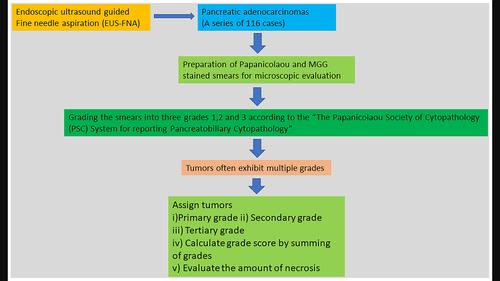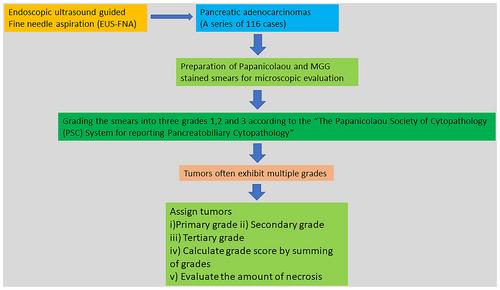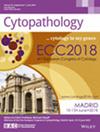Grading pancreatic adenocarcinomas on fine needle aspiration cytology. The outstanding issues
Abstract
Objective
The three-tier grading scheme described in “The Papanicolaou Society of Cytopathology (PSC) System for reporting Pancreaticobiliary Cytopathology” (TPSCRPBC) which remained unchanged following the WHO Reporting System for Pancreaticobiliary Cytopathology (WRPBC) was evaluated on pancreatic adenocarcinomas (PACs) reported on endoscopic ultrasound-guided fine needle aspiration cytology (EUS-FNAC).
Methods
The Papanicolaou and May Grunwald Giemsa-stained smears from 116 cases of PACs were graded using the three-tier grading scheme laid down by TPSCRPBC/WRPBC. Cases exhibiting multiple grades were assigned primary, secondary and tertiary grades. Each case was assigned a grade score, either by adding the primary and secondary grades, by adding the primary and tertiary grades when the tertiary grade was 3 or by doubling the grade when only one grade existed. Necrosis was estimated semi-quantitatively. The inter-observer reproducibility in grading was evaluated using Kappa and Kendall's tau-c. Correlations between the various grades, the stage of the tumour and the amount of necrosis were assessed using Spearman rho and Kendall's tau-b.
Results
31.89% of cases showed one grade, and 68.11% showed at least two grades. 16.38% showed three grades. The two commonest grade scores were 3 and 5. The inter-observer reproducibility for grading and grade scoring was satisfactory. A positive correlation was noted between the grades and the amount of necrosis. No significant correlation was found between the grades, grade scores and the stage of the tumours.
Conclusions
The TPSCRPBC/WRPBC grading scheme can be suitably applied to PACs with good inter-observer reproducibility. Cases often show multiple grades in the same tumour.



 求助内容:
求助内容: 应助结果提醒方式:
应助结果提醒方式:


